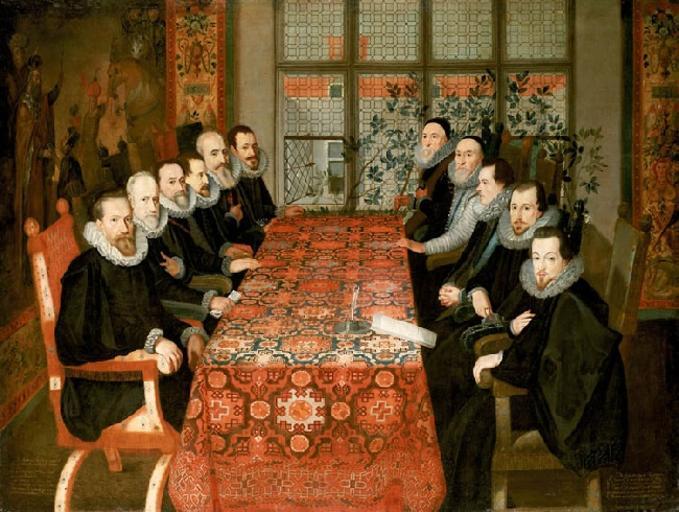MAKE A MEME
View Large Image

| View Original: | The_Somerset_House_Conference,_19_August,_1604.jpg (650x490) | |||
| Download: | Original | Medium | Small | Thumb |
| Courtesy of: | www.flickr.com | More Like This | ||
| Keywords: WIKIPEDIA: The Treaty of London, signed on 18 May (24 May) 1604, concluded the nineteen-year Anglo-Spanish War. The negotiations took place at Somerset House in London and are sometimes known as the Somerset House Conference. After the death of Queen Elizabeth in 1603, her successor James I quickly sought to end the long and draining conflict. Philip III of Spain, who also had inherited the war from his predecessor, Philip II, warmly welcomed the offer and ordered the commencement of the difficult negotiations that followed. The Anglo-Spanish War had been a complex and fluctuating conflict which also had connections with the Eighty Years' War in the Netherlands, the French Wars of Religion, and the Nine Years' War in Ireland. The terms of the treaty were favourable to Spain, as they brought to an end English support to the Dutch rebellion since the Treaty of Nonsuch (1585), and the end of attacks upon Spanish sea trade.[4] At the same time, the treaty amounted to an acknowledgement by Spain that its hopes of restoring Roman Catholicism in England were at an end. Following the signing of the treaty, England and Spain remained at peace until 1625. English delegation * Robert Cecil, 1st Earl of Salisbury (1563-1612), Secretary of State, James I's leading minister. * Charles Blount, 1st Earl of Devonshire (1563-1606), Soldier. * Thomas Sackville, 1st Earl of Dorset (1536-1608), Poet and Lord Treasurer. * Henry Howard, 1st Earl of Northampton (1540-1614), Lord Warden of the Cinque Ports. * Charles Howard, 1st Earl of Nottingham (1536-1624), Lord High Admiral. Spanish delegation Only two of the Spanish delegates were Spaniards, the rest coming from the King of Spain's other territories. * Charles de Ligne, prince-count of Arenberg, * Juan Fernández de Velasco, 5th Duke of Frías, Constable of Castile. * Jean Richardot, President of the Brussels Privy Council. * Alessandro Robida, Senator of Milan. * Louis Vereyken, Audiencier of Brussels. * Juan de Tassis, Count of Villa Mediana. WIKIPEDIA: The Treaty of London, signed on 18 May (24 May) 1604, concluded the nineteen-year Anglo-Spanish War. The negotiations took place at Somerset House in London and are sometimes known as the Somerset House Conference. After the death of Queen Elizabeth in 1603, her successor James I quickly sought to end the long and draining conflict. Philip III of Spain, who also had inherited the war from his predecessor, Philip II, warmly welcomed the offer and ordered the commencement of the difficult negotiations that followed. The Anglo-Spanish War had been a complex and fluctuating conflict which also had connections with the Eighty Years' War in the Netherlands, the French Wars of Religion, and the Nine Years' War in Ireland. The terms of the treaty were favourable to Spain, as they brought to an end English support to the Dutch rebellion since the Treaty of Nonsuch (1585), and the end of attacks upon Spanish sea trade.[4] At the same time, the treaty amounted to an acknowledgement by Spain that its hopes of restoring Roman Catholicism in England were at an end. Following the signing of the treaty, England and Spain remained at peace until 1625. English delegation * Robert Cecil, 1st Earl of Salisbury (1563-1612), Secretary of State, James I's leading minister. * Charles Blount, 1st Earl of Devonshire (1563-1606), Soldier. * Thomas Sackville, 1st Earl of Dorset (1536-1608), Poet and Lord Treasurer. * Henry Howard, 1st Earl of Northampton (1540-1614), Lord Warden of the Cinque Ports. * Charles Howard, 1st Earl of Nottingham (1536-1624), Lord High Admiral. Spanish delegation Only two of the Spanish delegates were Spaniards, the rest coming from the King of Spain's other territories. * Charles de Ligne, prince-count of Arenberg, * Juan Fernández de Velasco, 5th Duke of Frías, Constable of Castile. * Jean Richardot, President of the Brussels Privy Council. * Alessandro Robida, Senator of Milan. * Louis Vereyken, Audiencier of Brussels. * Juan de Tassis, Count of Villa Mediana. | ||||